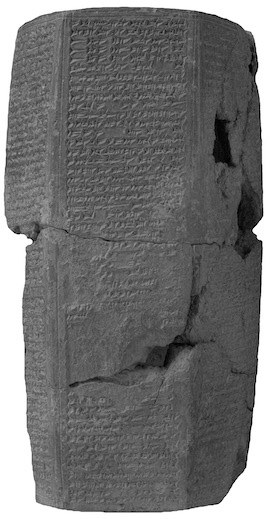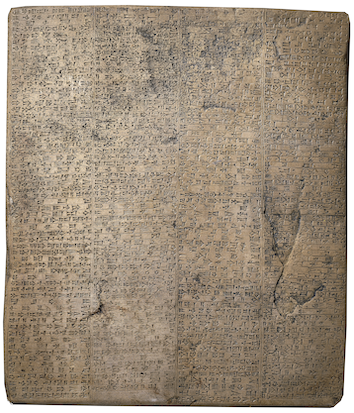Eumuša (cella of Marduk in Esagil at Babylon)

Eumuša, the cella of the god Marduk, was the most important room of Esagil, Babylon's principal temple. Despite its importance, little about its building history is know in presently-extant cuneiform sources. Ashurbanipal (r. 668–ca. 631 BC), Assyria's last great king, and Nebuchadnezzar II (r. 604–562 BC), the second king of the Neo-Babylonian Empire (625–539 BC) are the only two rulers who specifically record in their inscriptions that they carried out work on Eumuša, which was located west of the Court of Bēl. Although excavations were carried out on Esagil by the Deutsche Orient-Gesellschaft (DOG) and Königliche Museen Berlin (KMB) in 1899–1917, first under the direction of Walter Andrae in 1900 and by Friedrich Wetzel and Klaus Müller in 1910–11, Marduk's cella was not excavated.

BM 121006+, a six-column clay prism that is inscribed with the so-called "Prism T[hompson] Inscription" of Ashurbanipal. Work on Esagil and some of its cult objects is recorded in col. i. © Trustees of the British Museum.
Names and Spellings
The Sumerian ceremonial name of Marduk's cella in Esagil is Eumuša, which means "House of Command." This part of Babylon's principal temple is referred to in Akkadian royal inscriptions of the Neo-Babylonian king Nebuchadnezzar II as "the cella of the Enlil of the gods, the god Marduk" (Akkadian papāha enlil ilī marduk, "the cella of his (Marduk's) supreme power" (Akkadian papāha ellilūtīšu), and "the cella of his (Marduk's) dominion" (Akkadian papāha bēlūtīšu).
- Written Forms: e₂-umuš-a.
The cella's main gate, Kasulima (also called Kasilima), is sometimes used as the name of Marduk's cella. The Sumerian ceremonial name means "Gate of Radiance" ("Gate of Well-Being" for Kasilima).
Known Builders
- Neo-Assyrian (ca. 911–612 BC)
- Esarhaddon (r. 680–669 BC)
- Ashurbanipal (r. 668–ca. 631 BC)
- Neo-Babylonian (ca. 625–539 BC)
- Nebuchadnezzar II (r. 604–562 BC)

BM 129397, a large stone tablet that bears a long Akkadian inscription that is now commonly referred to as the "East India House Inscription." The description of Nebuchadnezzar's decoration and roofing of Marduk's cella is recorded in lines ii 43–50. Image adapted from the British Museum Collection website. Credit: Trustees of the British Museum.
Building History
Although the Neo-Assyrian king Esarhaddon does not explicitly state that he rebuilt Marduk's cella Eumuša, it is clear that constructing this part of Babylon's principal temple was part of that work and, therefore, he should be regarded as one of its builders. In 669 BC, Esarhaddon died, leaving many building projects at Babylon unfinished. Despite Šamaš-šuma-ukīn being the king of Babylon, Ashurbanipal took it upon himself to complete his recently-deceased father's unfinished projects. Work on Eumuša was one of them.
According to Akkadian inscriptions written on clay cylinders and stone steles, Ashurbanipal made Eumuša glisten "like the stars of the firmament." In addition, he might have had this part of Esagil roofed with cedar and cypress beams transported from the Levant. Between 668 BC and 652 BC, this Assyrian king's workmen created an entirely new throne-dais (Akkadian paramāhu) from bricks cast from a vast quantity a silver alloy called zahalû. The 50 talents (1,500 kg/3307 lbs) of metal used for creating this new throne base, which might have gone by the name "Tiamat" (the name of Marduk's seat according to Tablet II of the scholarly compendium Tintir = Babylon), likely came from the abundance of zahalû-metal that the Assyrian army brought back as booty from the Egyptian metropolis Thebes (ca. 664 BC), in particular from two obelisks that were reported to have been cast with this silver alloy. Around the same time, or in conjunction with the creation of the cast-brick throne-dais, Ashurbanipal had his craftsmen build a canopy (Akkadian ermi Anu) from musukkannu-wood (a hard wood) and clad with thirty-four talents and twenty minas (1020.8 kg/2250 lbs) of reddish gold. That covering was stretched out over Marduk's statue, which sat atop the throne-dais.
During his work on the main building of Esagil, the Neo-Babylonian ruler Nebuchadnezzar II renovated and roofed Eumuša, together with Ezida (the cella of the god Nabû) and Kahilisu (here used as the name of the goddess Zarpanitu's cella Edara'ana). Several Akkadian inscriptions of his, including one written on a large stone tablet (the so-called "East India House Inscription") and a few written on rock faces in Lebanon, record that he lavishly decorated Marduk's cella and roofed it with beams of cedar imported from the Levant. The relevant passages of the "East India House Inscription" read:
Archaeological Remains
The location of Eumuša is almost certainly located in the still-not-well-excavated complex of rooms located immediately west of western façade of the Court of Bēl (the central courtyard of the main part of Esagil), although this has not yet been confirmed in the archaeological record. This assumption is based on the locations of the main cellas of Ezida at Borsippa (the temple of the god Nabû) and Ebabbar at Sippar (the temple of the god Šamaš), two other "grand north-Babylonian" style temples. Although Eumuša and its main gate Kasulima (Kasilima; = unexcavated Gate m) have not yet been scientifically explored, a small portion of the main building of Esagil dedicated to Marduk — Kagal (= Gate h), the entranceway that gave access to and from the Court of Bēl, and Marduk's ante-cella (= Room 18) and its side chambers — were (partially) excavated by means of pits and tunnels in 1910–11, under the direction of Friedrich Wetzel and Klaus Müller. At the present time, nothing can be said about the archaeological remains of Eumuša.
Further Reading
- George, A.R. 1992. Babylonian Topographical Texts (Orientalia Lovaniensia Analecta 40), Leuven, pp. 268–269, 389–391, and 401–403.
- George, A.R. 1993. House Most High. The Temples of Ancient Mesopotamia (Mesopotamian Civilizations 5), Winona Lake, p. 156 no. 1176.
- George, A.R. 1995. "The bricks of E-sagil," Iraq 57, pp. 173–197.
Banner image: areal photograph of the excavation pits and trenches in the area of the remains of Esagil and Etemenanki taken in 1923 (left); a reconstruction of Esagil and Etemenanki during the reign of the Neo-Babylonian king Nebuchadnezzar II (center); a plan of Esagil, and Etemenanki (right). Images from O. Pedersén, Babylon: The Great City, pp. 144–145 figs. 4.3–4.4 and p. 151 fig. 4.11.
Jamie Novotny
Jamie Novotny, 'Eumuša (cella of Marduk in Esagil at Babylon)', Babylonian Temples and Monumental Architecture online (BTMAo), The BTMAo Project, a sub-project of MOCCI, [http://oracc.org/btmao/Babylon/TemplesandZiggurat/Esagil/RoomsandGates/Eumusha/]